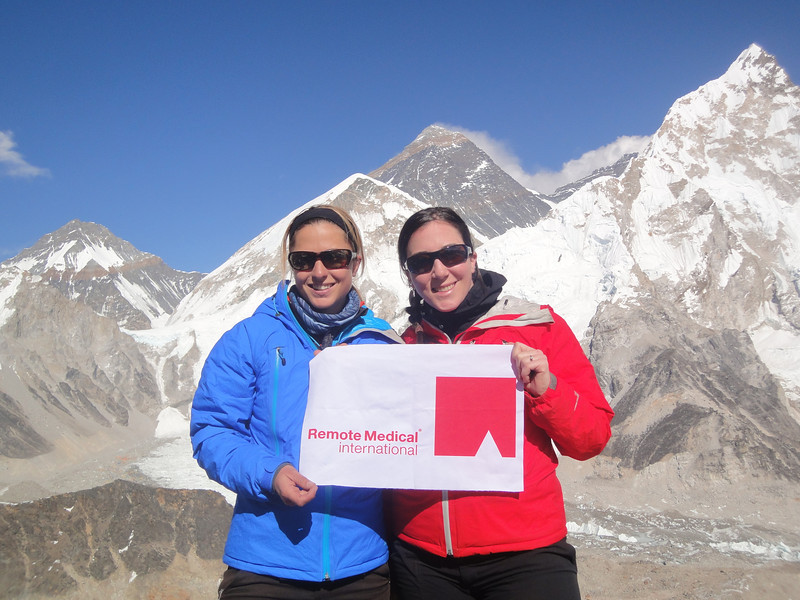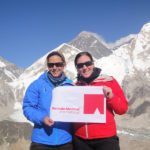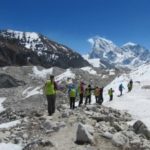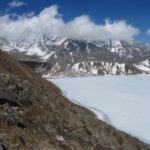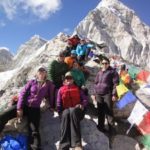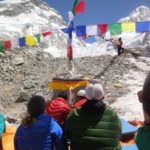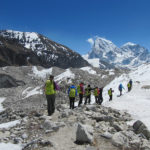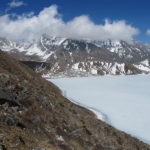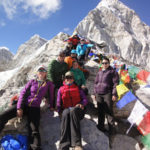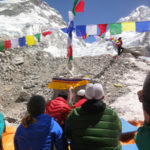
Christine, RMI Director of Administration, and Melissa Arnot, RMI Instructor & American Mountaineer, at the Summit of Kala Pattar (SP)
On March 26, RMI Director of Administration Christine Avakian and eight of her friends joined American Mountaineer and RMI Instructor Melissa Arnot on a sixteen-day trek to Everest Base Camp. After parting ways, Melissa embarked on her sixth Everest expedition. If successful, this will be her fifth Everest summit. As Melissa continues her expedition, Christine—back at Seattle headquarters—tells us a little bit about journey.

Melissa and I have been good friends since she began working for RMI in 2005, so I’ve always participated in her expeditions in one form or another. Most of the time that means listening to her stories or following the news, but I also met her at base camp in 2009 after her second Everest summit. I trekked out there by myself with a guide and a porter and used a variation of the route that our group took this time around.
So, while this was sort of “round two†for me, it was also a completely different experience trekking with my fiancé, Clint, and eight of our friends. There were two important elements for me. One—this was more or less our honeymoon, so sharing this with Clint was really incredible. Two—I was able to actually trek with Melissa this time around which completely transformed the experience. Spending twelve days with Melissa and seeing her environment firsthand was remarkable. Nepal is where she lives half the year, and she’s been going there twice a year for six years. It was a truly cultural experience to see how Melissa interacts with her Nepali team. When I went alone I was a visitor, and this time I felt like a real participant because we were traveling with a member of that community. There was full integration and true cultural immersion.
In addition to all of those reasons, I also decided to go because, well, it’s an epic adventure with great friends. How can you turn that down?
What about the logistics? What route did you take and how long were you gone?
We hiked over eighty miles in sixteen days and started the trek in Lukla. We made stops in Phakding, Namche Bazaar, Thame, Lungden, Gokyo, Dragnag, Lobuche, and Gorak Shep before arriving at base camp. From base camp we returned via Pangboche, Namche Bazaar, and back to Lukla. The longest leg was fifteen or so miles between Dragnag and Lobuche
What was the most challenging part of the trek?
There were two passes in particular that were really challenging. The first was Renio La Pass between Lungden and Gokyo. I got a little dizzy and lightheaded towards the top of that pass, and there was a steep drop-off making me nervous. I really had to turn off the pain monitor at the point and focus on putting one foot in front of the other. Honestly, I actually listened to a lot of Macklemore at high altitude. You get to a difficult part of the trek, put on a good beat—something you would jam out to in your car—and tune out the pain.
The second pass was Cho La Pass between Dragnang and Lobuche. That section was especially difficult because there was more snow on the route than usual for that time of year. Both passes were 17,800 feet, and it’s the ups and downs that wear you down on a long day at altitude. That kind of challenge is tough to prepare for, mentally and physically.
And the most rewarding part?
That comes right after the challenge. You trudge up this pass without crampons, and you’re just feeling like shit. When it’s over, you stop and look up to find this breathtaking panoramic view. It’s in your face, and it’s huge. It’s bigger, closer, and taller with more jagged mountains than you’ve ever seen in your life. You’re just awestruck. Then you turn around and look back down at where you came from, and you feel like a badass. It’s an incredible feeling of accomplishment.
But there are so many rewarding parts. Getting to base camp and sleeping there is incredible as well. I felt so privileged to experience that part of Melissa’s life and to get to know her Nepali family. Walking with Tshering Dorje, her lead Sherpa, was absolutely incredible. Here’s a guy who has summited Everest over a dozen times—he’s the biggest badass in the world—and he insists on filling my tea when we stop. I have an amazing amount of gratitude and respect for that man.
Is it safe to assume that there was a ton of preparation, especially physical training, for this trip?
… [Pauses] Yes. A lot of…training.
No, to be honest, I hiked Mt. Si a couple of times, and that was about it. Yoga, soccer, skiing—but that probably isn’t the best form of preparation. Really, physical preparation only goes so far at high altitude. Even those that are the most prepared still succumb to a stomach bug or elevation issues. Besides being in overall good health, there isn’t much to do in the way of preparation for this type of trek.
I will say that one thing our group did really well is communicate. We had planned group discussions over dinner where everyone would check in about how they were feeling. Again, everyone reacts differently to altitude, so it’s important to keep the group updated on your status. One person in our group is a summer camp director, so he led the check-ins. It really did feel like adult summer camp at times, but it helped us monitor our own symptoms as well as each other’s.
What medical supplies did you bring?
We had a large first aid kit and a drug box with personal prescriptions. I mostly relied on Z-Packs, Diamox, Ambien, Excedrin, and Tums. Everyone also had a small first aid kit with similar items. Medically speaking, it’s difficult to know how your body is going to respond at altitude. You have to be prepared for every possible scenario, and—thanks to RMI’s help—we had the supplies we needed.
How did the group do in terms of injuries?
We were really lucky overall. There was a minor sprained ankle, but besides that it was mostly what you would expect: blisters, bad headaches, stomach issues, and dehydration. One person in the group became anemic and another started to lose vision, but both issues were taken care of appropriately.
Sleeping high altitude environments poses all kinds of difficulties. Clint, for example, experienced Cheyne-Stokes respiration which is an abnormal pattern of breathing that happens to some people while they sleep in high altitude environments. I would wake up to him taking these big, deep breaths, and then he wouldn’t breathe for six or seven seconds. He would wake up and feel like he was suffocating. We relied a lot on Ambien because, unlike other sleeping medications, it doesn’t reduce your respiratory rate. It’s important to keep your oxygen intake high at elevation, and it’s also important to be well rested.
Now that you’re back, are you able to keep track of Melissa? Where is she now?Â
She’s either making the summit push or doing acclimatization rotations. It’s tough to put a timeframe on the climb, but she’s expected to summit sometime in May. This month, May 1 in particular, is the fiftieth anniversary of the first Everest summit by an American. It’s an exciting time for Melissa to be climbing.
But, really, the whole process is exciting. We were able to share some really cool experiences with her. At base camp, for example, we participated in her puja ceremony where climbers pay homage to the mountain goddess, Miyolangsangma. Then in Pangboche, Melissa received her individual blessing from Lama Geshe, the climbing Lama, before we parted ways. I can’t say it enough: it was an incredible experience.
Thanks for taking the time to tell us about it. I know you just got back, but what’s next on your bucket list?
I would love to do a long trek to a remote ruin in Peru with my dad. But I’m also looking towards other types of adventures—maybe a kayak trip in New Zealand or a long bike tour. Then there’s always Mt. Rainier and, at some point, hiking the Washington part of the Pacific Crest Trail.
